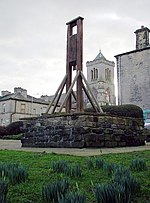King Cross
Areas of Halifax, West YorkshireUse British English from May 2022
King Cross, originally the site of an ancient stone cross, is an ecclesiastical parish created in 1845 in the Metropolitan Borough of Calderdale, West Yorkshire, England. Part of the Diocese of Wakefield, it is located along the top of a ridge above the town of Halifax. The A58 road into Lancashire divides here, with one fork, the A646, branching off towards Burnley via Hebden Bridge and the other going to Littleborough via Sowerby Bridge. During the English Civil War, when Halifax was a Royalist stronghold, King Cross was a key outpost, with the Parliamentarians holding parts of the Calder Valley.
Excerpt from the Wikipedia article King Cross (License: CC BY-SA 3.0, Authors).King Cross
King Cross Road, Calderdale King Cross
Geographical coordinates (GPS) Address Nearby Places Show on map
Geographical coordinates (GPS)
| Latitude | Longitude |
|---|---|
| N 53.716 ° | E -1.879 ° |
Address
King Cross Road
King Cross Road
HX1 3LN Calderdale, King Cross
England, United Kingdom
Open on Google Maps










